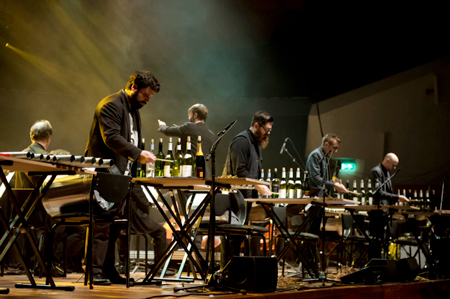by Daniel Hathaway

Not wasps: the evening began with Ralph Vaughan Williams’s Overture to The Wasps, written as part of the incidental music for an Oxford University amateur production of Aristophanes’ ancient Greek comedy. There’s plenty of buzzing in the piece, but instead of representing insects, the music lampoons noisome jurors during a particularly litigious period in Athens. Wilkins and the Orchestra gave the tuneful work a vital, beautifully-blended performance.
Not birds: Tan Dun’s Secret of Wind and Birds features plenty of avian-like sounds, but those were produced on Saturday by recordings of traditional Chinese instruments — guzheng, suona, erhu, pipa, dizi, and sheng — played through the smartphones of audience members who had downloaded a special app before the performance.
Written for the 2015 National Youth Orchestra’s tour to China, the piece is in Tan Dun’s engaging cinematic style, familiar to moviegoers who have heard his score to Crouching Tiger, Hidden Dragon. In the course of a passacaglia, a theme that uncannily resembles the persistent motive at the end of Sibelius’s Fifth Symphony gets passed around the orchestra. Players not otherwise occupied eventually even hum the melody, adding a lovely effect to the texture.
Wilkins prompted the audience about their role in the piece but trusted them to perform without rehearsal. When he cued their three entrances, a lovely soft din arose from every part of the hall. The cutoffs weren’t quite so neat — a few birds chirped on past their welcome — but the general effect was delightful.
Not planets: and Gustav Holst’s famous suite, The Planets, isn’t about heavenly bodies orbiting around the Sun, but captures in music the attributes of astrological signs. The expanded Akron Symphony, exotified by such instruments as a bass oboe and a tenor tuba, enriched by the deep tones of a digital organ, and spatialized by a hidden female chorus who sounded as though they were singing from a distant solar system, gave the work an electrifying performance at the end of the evening. Outside of a few burbled notes, the brass were spectacular, and shapely incidental solos from winds and strings abounded.
In contrast to those three works, David Lang’s man made sets out to represent only itself, but the instruments he calls for are decidedly unusual. Sō Percussion, the evening’s star attraction, began the piece by “playing” Asian Willow twigs and wine bottles before moving on to more conventional orchestral instruments.
Lang, who was present on Saturday, is one of the founders of New York’s Bang On A Can Festival. From the stage, he described man made as a dialogue between the percussion quartet and the orchestra where the soloists present ideas on invented instruments and the orchestral percussionists translate them into “something that can be approximated by more traditional percussion instruments.” The rest of the orchestra catches on and joins in.
The beginning was droll. Eric Cha-Beach, Josh Quillen, Adam Sliwinski, and Jason Treuting took chairs at the front of the stage next to tables piled with willow branches, with wine bottles lined up behind. With utter solemnity, the quartet snapped the twigs together or sequentially, creating various rhythmic patterns which were taken up by the orchestra. That went on for some time. Then the quartet rose, picked up mallets, and began playing glassy tones on the bottles. Finally, they joined the percussion section for a lengthy, all-out din of repetitive rhythmic and melodic patterns — the orchestral equivalent of English change ringing, where bells follow a subtly-evolving mathematical pattern for hours.
Depending on how you feel about “Repetitive Music,” the results on Saturday were either fascinating or tedious. What’s certain is that the musicians of Sō Percussion are remarkable practitioners of their craft. Their theatrical capabilities and musical sensitivities are extraordinary. The audience was swelled by young people, many of whom had spent part of the week soaking up the ensemble’s music in a series of workshops and rehearsals — perhaps the most impactful feature of the Akron Symphony’s second collaboration with Tuesday Musical. We can’t wait to see what’s next.
Published on ClevelandClassical.com October 17, 2016.
Click here for a printable copy of this article



